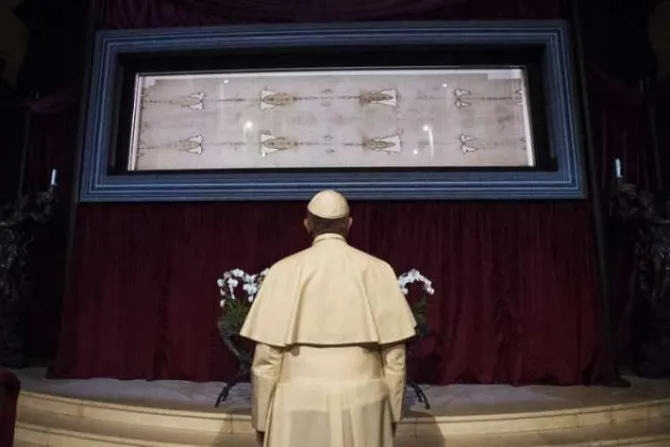Vatican City, Jul 23, 2018 / 13:46 pm
Several experts have questioned the scientific validity of a study on the Shroud of Turin that concluded that almost half the blood stains were "painted on," based on simulations and photographs without the authors of the study having had access to the original linen cloth.
Forensic anthropologist Matteo Borrini and the chemist Luigi Garlarschelli published last week in the Journal of Forensic Sciences a paper on the Shroud based on the bloodstain patterns used to investigate crime scenes.
The Italian authors did not have access to the original linen cloth in the Turin cathedral, but based their experiments on photographs and models --including mannequins--which, for their critics are not scientifically equivalent to the cadaver that the shroud would have covered.
Borrini, a medical doctor maintains that the stains "aren't realistic" and believes that "the stains were artificially made" because according to his simulations, blood should have flowed in other directions.
Emmanuella Marinelli, a scientist who has studied the Shroud of Turn since 1977 and has written more than 300 articles and several books on the subject questioned the methodology of Borrini's study in a statement to ACI Prensa, the Spanish language sister agency of CNA.
"It clearly is not the same thing" to rely on a photograph and not have recourse to the shroud, Marinelli pointed out.
"These two investigators were among the group of scientists that have directly studied the shroud, and they have never seen it up close. Perhaps they have never even seen it from a ways off," Marinelli also stated in La Nuova Bussola Quotodiana, an online news site published in Italian.
The authors state that they made their tests with real and synthetic blood applied both on volunteers and on mannequins. The stains that they consider to be disproven are found on the forearms and on the lumbar area.
In comments to reporters, the study's authors deny the authenticity of the relic and refer to it as an "artistic or didactic representation of the passion of Christ done around the 14th century."
"Neither of the investigators have the scientific qualifications to speak on it," since as an anthropologist and a physician, the pair does not "have experience in human bloodstains," explained Alfonso Sánchez Hermosilla, a doctor and forensic anthropologist of the research team of the Spanish Sindonology Center.
"In their study they say that the bloodstains they observed don't match up to those they obtained in their experiment, but they don't have the necessary knowledge and so they did not adequately design the experiment, and that is why their conclusions lack any scientific value," he told ACI Prensa.
For Sánchez Hermosilla, since it doesn't have "any value scientifically, (the study) should not have been published in a serious journal."
Professor Paolo Di Lazzaro, vice-rector of the International Center of Sindonology of Turin, noted in a letter published by his diocese that the conditions under which bloodstains emanating from a tortured man and subjected to extreme conditions are produced are very different from those of a volunteer in good health or a mannequin, such as those studied by Borrini and Garlarschelli.
"It's not possible to think that realistic conditions of the path taken by the blood on the body of a crucified man can be reproduced without considering all the factors that may have influenced that path in an important way," he said.
The Shroud of Turin, also called a "sindon," is a linen cloth 14 feet 5 inches long by 3 feet 7 inches wide, which shows the image of a man tortured and crucified. It is held by many Catholics to be the burial cloth that wrapped the body of Jesus after his death on the cross, though the Church's position on the shroud is one of neutrality.
It has been in Turin, Italy since 1578, has been the subject of thousands of scientific investigations from diverse specialties, and more than 32,000 photographs have been taken of it.
(Story continues below)
The last time it was exposed to the public was in 2015. It will be exhibited next August for a few days before a large group of Italian youths on pilgrimage.
This article was originally published by our sister agency, ACI Prensa. It has been translated and adapted by CNA.


